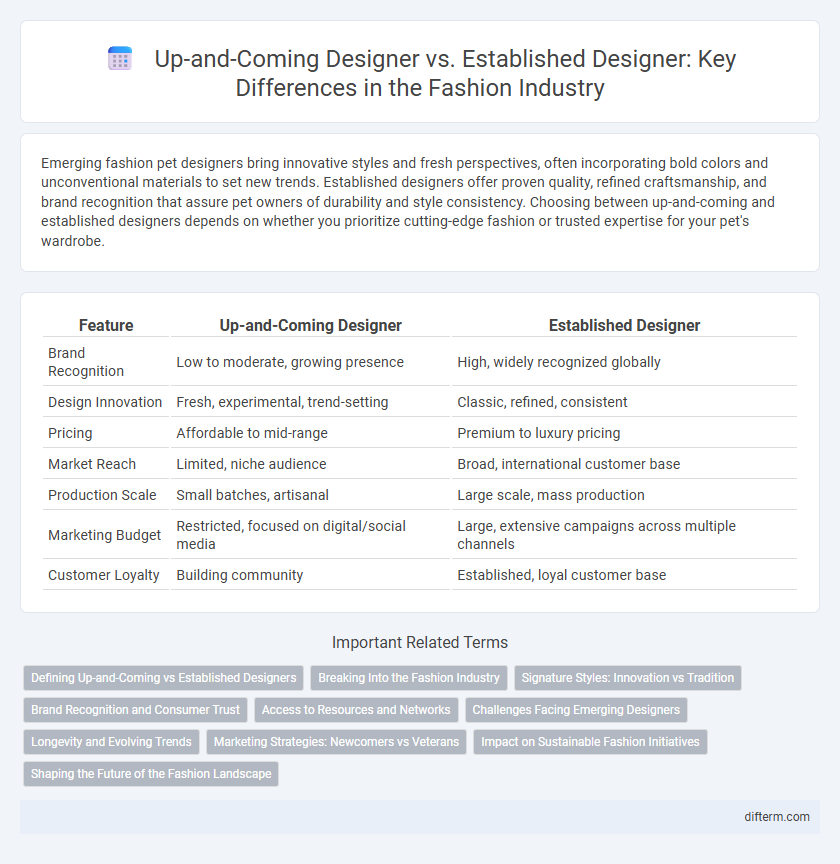Emerging fashion pet designers bring innovative styles and fresh perspectives, often incorporating bold colors and unconventional materials to set new trends. Established designers offer proven quality, refined craftsmanship, and brand recognition that assure pet owners of durability and style consistency. Choosing between up-and-coming and established designers depends on whether you prioritize cutting-edge fashion or trusted expertise for your pet's wardrobe.
Table of Comparison
| Feature | Up-and-Coming Designer | Established Designer |
|---|---|---|
| Brand Recognition | Low to moderate, growing presence | High, widely recognized globally |
| Design Innovation | Fresh, experimental, trend-setting | Classic, refined, consistent |
| Pricing | Affordable to mid-range | Premium to luxury pricing |
| Market Reach | Limited, niche audience | Broad, international customer base |
| Production Scale | Small batches, artisanal | Large scale, mass production |
| Marketing Budget | Restricted, focused on digital/social media | Large, extensive campaigns across multiple channels |
| Customer Loyalty | Building community | Established, loyal customer base |
Defining Up-and-Coming vs Established Designers
Up-and-coming designers are characterized by their innovative approaches, fresh perspectives, and growing recognition within the fashion industry, often marked by recent runway debuts or emerging brand presence. Established designers hold extensive industry experience, a well-defined signature style, and a loyal global clientele built over years or decades, often influencing fashion trends at major fashion weeks. The distinction hinges on market influence, brand maturity, and the scale of commercial success.
Breaking Into the Fashion Industry
Emerging designers break into the fashion industry by showcasing unique creativity and leveraging digital platforms like Instagram and TikTok to reach global audiences. Established designers benefit from brand legacy, extensive industry connections, and high-profile runway shows that solidify their market position. Navigating this landscape requires up-and-coming talent to balance innovative design with strategic networking to gain visibility and credibility.
Signature Styles: Innovation vs Tradition
Up-and-coming designers drive the fashion industry with bold innovation, often experimenting with avant-garde silhouettes and unconventional materials that challenge traditional aesthetics. Established designers maintain their signature styles by refining classic techniques, emphasizing heritage craftsmanship and timeless elegance that resonate with loyal clientele. This dynamic tension between innovation and tradition shapes the evolving landscape of contemporary fashion.
Brand Recognition and Consumer Trust
Up-and-coming designers face challenges in brand recognition compared to established designers, who benefit from years of market presence and loyal consumer bases. Established designers command higher consumer trust due to proven quality, consistent style, and reputable brand histories. New designers must leverage innovative marketing and unique design aesthetics to build recognition and foster trust among discerning fashion consumers.
Access to Resources and Networks
Up-and-coming designers often face limited access to high-quality materials and established industry networks, restricting their ability to showcase collections on major platforms. In contrast, established designers benefit from long-standing relationships with suppliers, fashion houses, and media outlets that facilitate smoother production processes and wider promotion. This disparity in resources and connections significantly impacts brand visibility and market penetration within the competitive fashion industry.
Challenges Facing Emerging Designers
Emerging fashion designers face significant challenges, including limited brand recognition, restricted access to high-quality materials, and difficulty securing financial backing compared to established designers with established networks and loyal customer bases. These designers also struggle with market saturation and the pressure to quickly adapt to rapidly changing consumer trends while maintaining unique creative visions. Building sustainable supply chains and scaling production remain critical hurdles that can hinder growth and visibility in a competitive fashion industry.
Longevity and Evolving Trends
Up-and-coming designers often bring fresh perspectives and innovative ideas that challenge traditional fashion norms, attracting younger audiences eager for new styles. Established designers, however, benefit from proven brand longevity and an ability to adapt evolving trends while maintaining a cohesive aesthetic that appeals to a broader market. Longevity in fashion relies on balancing innovation with consistency, allowing designers to remain relevant across multiple seasons and shifting consumer preferences.
Marketing Strategies: Newcomers vs Veterans
Up-and-coming fashion designers leverage social media platforms, influencer collaborations, and grassroots marketing to build authentic connections and rapidly grow their audiences. Established designers rely on traditional advertising, high-profile runway shows, and luxury brand partnerships to maintain their market dominance and reinforce brand prestige. Both use data-driven insights to tailor marketing campaigns, but newcomers prioritize digital engagement while veterans focus on legacy brand storytelling.
Impact on Sustainable Fashion Initiatives
Up-and-coming designers often drive innovation in sustainable fashion by experimenting with eco-friendly materials and circular design practices that challenge traditional production models. Established designers utilize their influential platforms and extensive resources to scale sustainable initiatives, integrating ethical sourcing and waste reduction across global supply chains. The combined impact of emerging creativity and established industry power accelerates the adoption of sustainable fashion principles worldwide.
Shaping the Future of the Fashion Landscape
Up-and-coming designers inject fresh perspectives and innovative techniques that challenge traditional norms, driving evolution within the fashion industry. Established designers leverage their legacy and global influence to set enduring trends and mentor emerging talent, ensuring continuity and growth. Together, they shape the future of the fashion landscape by blending innovation with heritage, creating a dynamic ecosystem that propels style forward.
up-and-coming designer vs established designer Infographic

 difterm.com
difterm.com